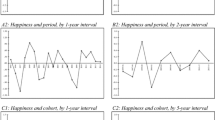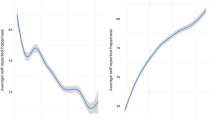Abstract
There is now much evidence for a remarkably consistent relationship between age and happiness—“the U curve.” In this paper, we present the first analysis that explores why some nations—and people within them—have turning points that are much earlier while others turn much later. Contributing to past studies, we analyzed the relationship within 46 individual countries, as well as how it varied depending on where in the well-being distribution individuals are, and extended the analysis to stress. The U-shaped relationship between age and happiness held in 44 of the 46 countries, and a reverse U held for stress in almost as many. Our most novel finding is that the timing of the turn varies depending on average country-level happiness and on individuals’ position in the well-being distribution. Our findings highlight the consistency of the relationship as well as how its timing varies across people and places.












Similar content being viewed by others
Notes
Estimates for ordered logit models do not modify our main findings; for a discussion of the use of OLS regressions to analyze ordinal well-being variables, see Van Praag and Ferrer-i-Carbonell (2007).
The two countries where the U curve does not hold are Mexico and South Africa.
Data was not found for Austria, Belgium, Denmark, Greece, Ireland, Kosovo, and Portugal.
The five countries where the U curve does not hold are Brazil, Chile, Colombia, India, and Montenegro.
The 12 countries where the stress curve does not hold are Austria, Denmark, Finland, France, Germany, Italy, Kosovo, Netherlands, Poland, Russia, Slovenia, and Sweden.
We thank Danny Blanchflower for suggesting this strategy and for sharing his results on Europe with us.
For brevity, we provide the figures for the USA only, given that it departs from the norm. As a robustness check, we replicated the exercise based on GSS data for 1972–1998, thus for a different time period and data set, and found again that the U curve was much steeper for the unmarried than the married. The U is less steep in the GSS data due to the bunching of responses on the median of a 3-point scale. Results are available from the authors.
Our findings without controls for the USA stand in stark contrast with those of Glenn (2009). He criticizes Blanchflower and Oswald for including any controls at all, and using GSS data finds no U shape when only controlling for age cohorts. Glenn argues that controlling for married people, who are happier and select into marriage, drives the U, but our results suggest that is not the full story.
Indeed, Guven et al. (forthcoming), using panel data for Germany, find that the probability of divorce is highest when there are asymmetries in happiness levels in marriages.
The finding holds for Europe whether or not we include co-habitators as married or not. In the US data, co-habitators are not labeled as a separate category and constitute a smaller proportion of the total than in Europe.
References
Binder M, Coad A (2011) From Average Joe’s happiness to Miserable Jane and Cheerful John: using quantile regressions to analyze the full subjective well-being distribution. J Econ Behav Organ 79(3):275–290. doi:10.1016/j.jebo.2011.02.005
Blanchflower D (2016) Adjusted and unadjusted age curves for Europe. Dartmouth University, Mimeo
Blanchflower DG, Oswald AJ (2008) Is well-being U-shaped over the life cycle? Soc Sci Med 66:1733–1749
Blanchflower DG, Oswald AJ (2016) Antidepressants and age in 27 European countries: evidence of a U-shape in human well-being through life. J Econ Behav Organ 127:45–68
Carstensen LL, Turan B, Scheibe S, Ram N, Ersner-Hershfield H, Samanez-Larkin GR, Brooks KP, Nesselroade JR (2011) Emotional experience improves with age: evidence based on over 10 years of experience sampling. Psychol Aging 26((1)):21–33
Cheng TC, Powdthavee N, Oswald AJ (2015) Longitudinal evidence for a midlife nadir in human well-being: results from four data sets. Econ J 125:589
Chuluun T, Graham C (2016) Local happiness and firm behavior: do firms in happy places invest more? J Econ Behav Org 125:41–56
De Neve J-E, Oswald AJ (2012) Estimating the influence of life satisfaction and positive affect on later income using sibling fixed effects. Proc Natl Acad Sci 109:49
J De Neve, Ed Diener, Louis Tay, Cody Xuereb (2013) The objective benefits of subjective well-being. In J. Helliwell, R. Layard, and J. Sachs (eds), World happiness report
Diener E, Chang MY (2011) Happy people live longer: subjective well-being contributes to health and longevity. Appl Psychol 3(1):1–43
Easterlin RA (2009) Happiness, growth, and the life cycle. Oxford University Press, Oxford
Glenn N (2009) Is the apparent U-shape of well-being over the life course a result of inappropriate use of control variables? A commentary on Blanchflower and Oswald (66: 8, 2008, 1733–1749) Soc Sci Med 69: 481–485
Graham C (2009) Happiness around the world: the paradox of happy peasants and miserable millionaires. Oxford University Press, Oxford
Graham C, Nikolova M (2015) Bentham or Aristotle in the development process? An empirical investigation of capabilities and subjective well-being. World Dev 68:163–179
Graham C, Pettinato S (2002) Happiness and hardship: opportunity and insecurity in new market economies. The Brookings Institution Press, Washington DC
Graham C, Eggers A, Sukhtankar S (2004) Does happiness pay? An exploration based on panel data from Russia. J Econ Behav Org 55(2004):319–342
C Graham, S Zhou, J Zhang (2015) Happiness and Health in China: The Paradox of Progress Global Econ Dev Working Papers 89. The Brookings Institution
C Guven, C Senik, H Stichnoth (forthcoming) You cannot be happier than your wife: happiness gaps and divorce. J Econ Behav Org
Helliwell J, Layard R, Sachs J (eds) (2013) World happiness report. Earth Institute Press, New York
Nikolova M, Graham C (2014) Employment, late-life work, retirement, and well-being in Europe and the United States. IZA J Eur Labor Studies 3(5)
E Proto, AJ Oswald (2014) National happiness and genetic distance: a cautious exploration. IZA Discussion Papers 8300. Institute for the Study of Labor, Bonn
Rauch J (forthcoming). The U-shape of happiness. New York: St. Martin’s Press
Sawhill I (2014) Generation unbound: drifting into sex and parenthood without marriage. The Brookings Institution Press, Washington DC
Schwandt H (forthcoming) Unmet aspirations as an explanation for the age U-shape in well-being. J Econ Behav Org
Sharot T (2011) The optimism bias. Current Biology 21(23):R.941-942
Steptoe A, Deaton A, Stone A (2015) Subjective well-being, health, and aging. Lancet 385:640–48
A Stone, Christopher Mackie (2013) Subjective well-being: measuring happiness, suffering, and other dimensions of experience. Washington, D.C.: Committee on National Statistics, Division of Behavioral and Social Sciences and Education, The National Academies Press, Washington DC
Stone AA, Schwartz J, Broderick J, Deaton A (2010) A snapshot of the age distribution of psychological well-being in the United States. Proc Natl Acad Sci 107:22
Van Ootegem L, Verhofstadt E (2015) Perceived capabilities as an aggregated indicator for well-being. Appl Res Qual Life Studies 10:615–629
Van Praag BMS, Ferrer-i-Carbonell A (2007) Happiness quantified: a satisfaction calculus approach, Revisedth edn. Oxford University Press, Oxford
Weiss A, King JE, Inoue-Murayama M, Matsuzawa T, Oswald AJ (2012) Evidence for a midlife crisis in great apes consistent with the U-shape in human well-being. Proc Natl Acad Sci 109(49):19949–19952. doi:10.1073/pnas.1212592109, published ahead of print November 19, 2012
C Wunder, A Wiencierz, J Schwarze, H Küchenhoff, S Kleyer, P Bleninger (2009) Well-being over the life span: semiparametric evidence from British and German longitudinal data. DIW Berlin Discussion Paper No. 889, Berlin
Acknowledgments
They thank George Akerlof, Danny Blanchflower, and Andrew Oswald for very helpful comments, as well as three anonymous reviewers and Klaus Zimmermann and the editorial team at the Journal of Population Economics. We also thank Jonathan Rauch for providing many helpful citations from the psychology literature, as well as for many helpful conversations.
Author information
Authors and Affiliations
Corresponding author
Ethics declarations
This study was funded by the endowment funds supporting Graham’s Leo Pasvolsky chair at Brookings. There are no conflicts of interest to report.
Additional information
Responsible editor: Klaus F. Zimmermann
The authors are, respectively, Senior Fellow at the Brookings Institution and prospective DPhil student at the University of Oxford.
Rights and permissions
About this article
Cite this article
Graham, C., Ruiz Pozuelo, J. Happiness, stress, and age: how the U curve varies across people and places. J Popul Econ 30, 225–264 (2017). https://doi.org/10.1007/s00148-016-0611-2
Received:
Accepted:
Published:
Issue Date:
DOI: https://doi.org/10.1007/s00148-016-0611-2




